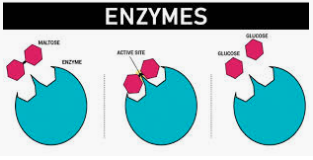ENZYMES Multiple Choice Questions :-
1. Enzyme-driven metabolic pathways can be made more efficient by
A. concentrating enzymes within specific cellular compartments
B. grouping enzymes into free-floating, multienzyme complexes
C. fixing enzymes into membranes so that they are adjacent to each other
D. All of the above
Answer: D
2. Which of the following (s) is/are serine proteases?
A. Chymotrypsin
B. Trypsin
C. Elastase
D. all of these
Answer: D
3. Which of the following statements about enzymes or their function is true?
A. Enzymes do not alter the overall change in free energy for a reaction
B. Enzymes are proteins whose three-dimensional form is key to their function
C. Enzymes speed up reactions by lowering activation energy
D. All of the above
Answer: D
4. Tryprotophan synthetase of E.coli, a typical bifunctional oligomeric enzyme consist of
A. a protein designated A
B. two proteins designated A and B
C. a protein A and one-subunit a
D. a protein designated B
Answer: B
5. What is the specificity of the Clostripain protease?
A. It cleave after Arg residues
B. It cleave after His residues
C. It cleave after Lys residues
D. None of the above
Answer: A
6. The proteolysis rate enhancement by chymotrypsin (~1010 folds) corresponds to a reduction in activation energy of about
A. 40 kJ/mol
B. 49 kJ/mol
C. 58 kJ/mol
D. 88 kJ/mol
Answer: C
7. Which of the following is false statement with regard to comparison between Serine and HIV proteases?
A. Both use nucleophilic attack to hydrolyze the peptide bond
B. Both require water to complete the catalytic cycle
C. Both forms an acyl-enzyme intermediate
D. Both show specificity for certain amino acid sequences
Answer: C
8. In the enzyme-catalyzed reaction shown below, what will be the effect on substances A, B, C, and D of inactivating the enzyme labeled E2?
A —(E1)—> B —(E2)—> C —(E3)—>
A. A, B, C, and D will all still be produced
B. A, B, and C will still be produced, but not D
C. A and B will still be produced, but not C or D
D. A will still be produced, but not B, C, or D
Answer: C
9. The nucleophile in serine proteases is
A. Serine
B. water
C. both (a) and (b)
D. Asparagine
Answer: C
10. The role of Asp 102 and His 57 during trypsin catalysis is to
A. neutralize the charge on the other’s side chain
B. keep the specificity pocket open
C. function as a proton shuttle
D. clamp the substrate into the active site
Answer: C

ENZYMES Objective type Questions with Answers
11. The cleavage specificity of trypsin and chymotrypsin depend in part on the
A. proximity of Ser 195 to the active site or specificity pocket
B. size, shape, and charge of the active site or specificity pocket
C. presence of a low-barrier hydrogen bond in the active site or specificity pocket
D. absence of water in the active site
Answer: B
12. The E.coli pyruvic acid dehydrogenase complex is reported to
A. decatalyze the oxidation of pyruvic acid to acetyl Co A and CO2
B. Catalyze the oxidation of pyruvic acid to acetyl Co A and CO2
C. retard the reduction of pyruvic acid to acetyl Co A and CO2
D. Catalyze the reduction of pyruvic acid to acetyl Co A and CO2
Answer: B
13. Which of the common features are shared between serine and aspartate proteases?
A. Both require water to complete the catalytic cycle
B. Both use a base to activate the nucleophile
C. Both show specificity for certain amino acid sequences
D. All of the above
Answer: D
14. Before they can react, many molecules need to be destabilized. This state is typically achieved through
A. changing the three-dimensional shape of the molecule
B. oxidizing the molecules by removing electrons
C. changing the reaction from a biosynthetic to a catabolic pathway
D. the input of a small amount of activation energy
Answer: D
15. Common feature in all serine proteases is a
A. hydrophobic specificity pocket
B. hydrophilic specificity pocket
C. cluster of reactive serine residues
D. single reactive serine residue
Answer: D